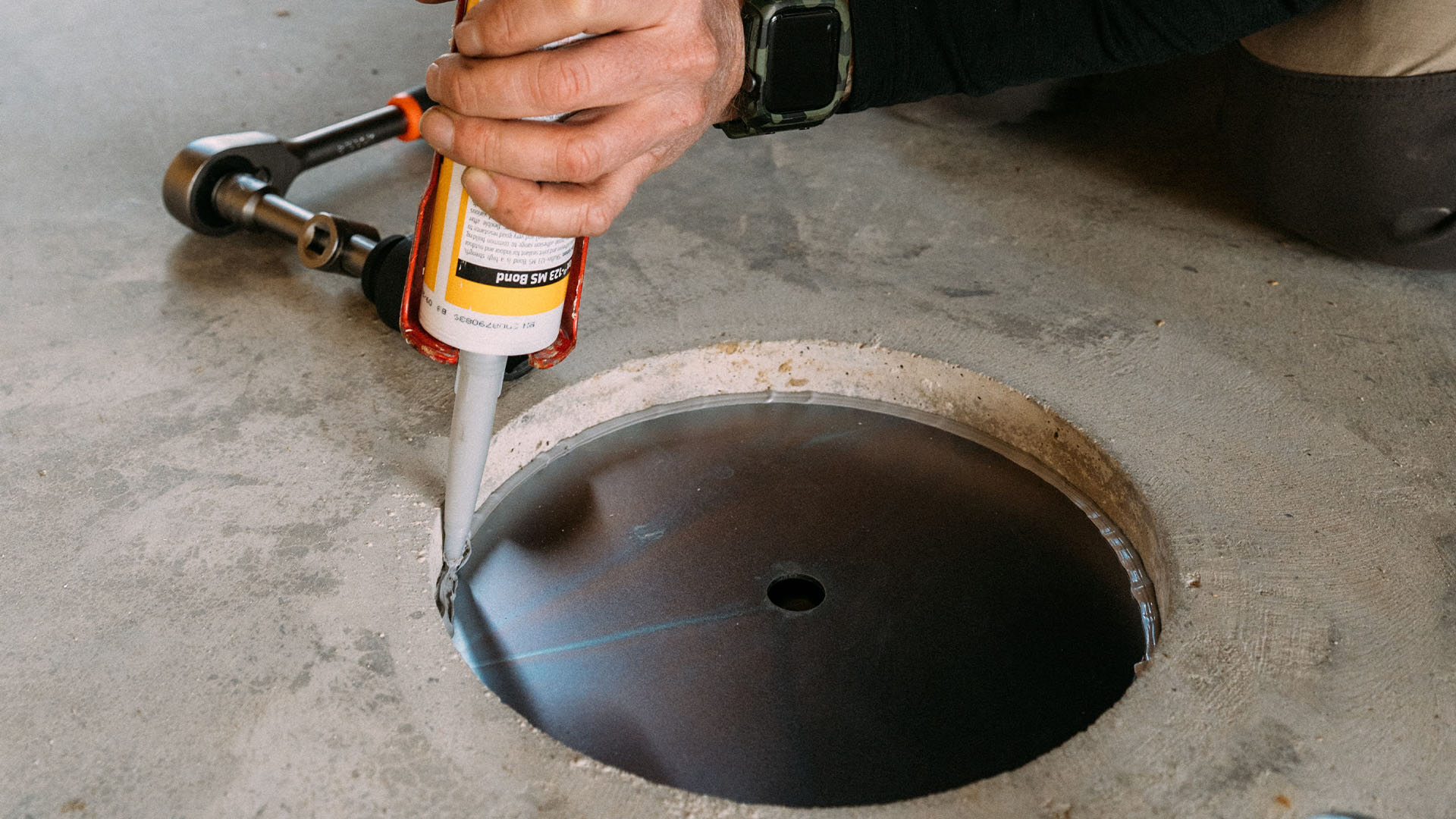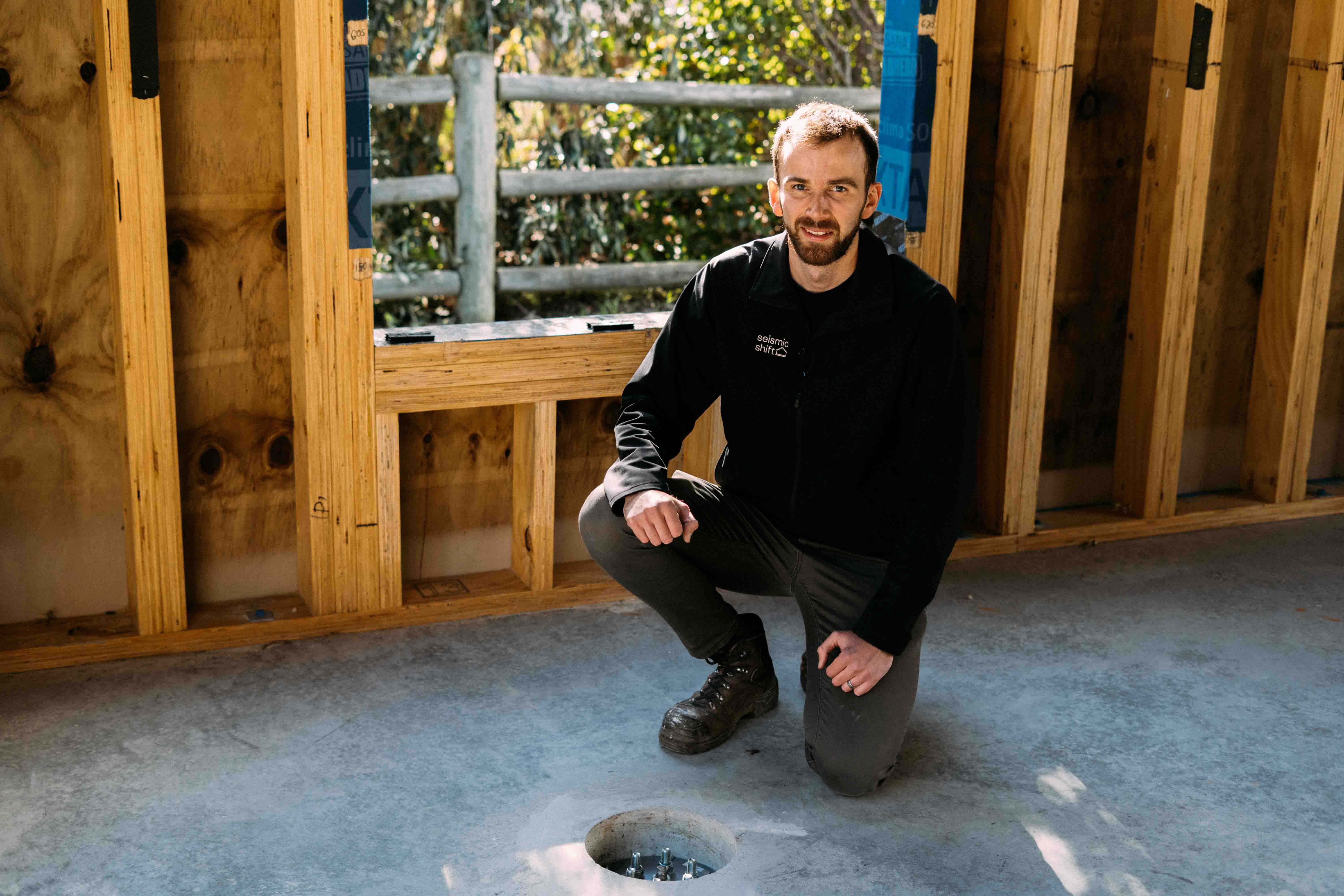
It’s been 15 years since Ben Exton was a student, digging silt and liquefaction from people’s homes.
The memory of digging silt from his great uncle's house and his great uncle breaking down in tears still sticks with him.
The Canterbury earthquakes happened during Exton's formative years, leading him to become a structural engineer. It's influenced his career trajectory so much so that along with Geoff Banks, a practicing structural engineer during the Canterbury earthquakes, they set up a company called Seismic Shift.
Seismic Shift aims to deliver affordable resilience to earthquake-prone communities. One of the products they've created is FrontFoot - a 12 kilogram metal disc that has upwards of 80 components.
So how does it work?
Exton says there’s a series of small concrete pads that are about half a metre in each direction and those are located at each of the locations of their devices which is spread across the floor plate.

A layer of special material goes over the top of those and then a concrete slab is carved over the top - just like a conventional house slab, he says. The devices fit into the slab on the top.
“They allow that slab to move relative to the ground and those isolated beds are effectively moving separately - they move with the ground so they move separately to the house," Exton says.
“It’s that movement that’s really key because when we allow something to move a little bit it generates some friction and that reduces the force, accelerations, displacement within the movement within the house above, so really if we dampen what the earth’s doing then the house is going to be better off.”
The 31-year-old says you can think about it like the shock absorbers in your car.
“What it’s designed to do is to allow the house to slide relative to the ground and when it slides, it absorbs energy and as it moves away from its neutral position, it builds up a restoring force which pushes the house back to its original position.”
“It’s really important because you need a house to be reset, ready for aftershocks,” Exton says.
The device is designed to be good for 50 years minimum with no maintenance - but the caveat is if there is a level of shaking beyond code level, then there is a requirement to inspect them.
Exton says when it comes to cost, the percentage of the building costs that you’re adding in is around 3% and at high volume, this would be down to 1.5%.
“We’re dealing with a building system that’s been going for a long time - you don’t want to have too many changes required. Also from a consenting perspective, we need to keep it as consistent with typical practice as possible.”

The general rule of thumb, Exton says, was about one FrontFoot device per 10 square metres but this would vary depending on where you were in the country and how heavy the house was.
Just last Friday they did their first installation of the devices in a 240 square metre home that is being built in Central Otago. The house had 23 FrontFoot devices installed.
So, why a focus on new builds? Exton says retrofitting would cost a lot more and there would be a lot of unknowns.
“How was the house actually built back in the 1930s or ‘40s? And what condition is it still in now?”
The overall philosophy, Exton says, is that with time, resilience will be built up in the building stock of New Zealand.
“So, as older homes are replaced with newer homes, the overall level of resilience increases across the country.”
Natural disasters and insurance
Insurance is a contentious topic in New Zealand - with a report published last week from advocacy organisation Consumer NZ highlighting several problems.
These problems include the rising costs of insurance and a growing number of New Zealanders ditching insurance because of the cost.
Academics told Consumer NZ the country has until 2040 before we start to see some insurers exiting Aotearoa. They also suggested some of the country’s main centres could see insurance retreat by the end of the decade.
Alongside this, insurance comparison website Quashed reported last week that the average New Zealand household with a car, contents and home insurance policy could now expect to pay over $5000 a year on their premiums.
With a spotlight on house insurance and insurers moving towards risk-based pricing, this was all flowing through, Quashed's chief executive Justin Lim said.
Exton says as people start to potentially see insurance withdrawal, this type of technology will allow them to take some control into their own hands.
“It’s very similar in Japan - they’re probably a wee bit further down the road than we are,” he says.
In Japan, the amount insured under earthquake insurance is between 30% to 50% of the coverage amount of someone’s fire insurance.
“Homeowners there are quite motivated to do something about it because they wear that risk personally. And so over there, if your house meets certain levels of performance, you can get insurance discounts.”
Exton says it’s encouraging to see other countries implementing insurance discounts for people who do more than the minimum.
Consumer NZ's report also mentioned the lack of discounts New Zealand consumers receive when it comes to insurance, noting that many insurers had stopped multi-policy discounts.
And questions remain over who will pay for the country’s adaptation measures when it comes to climate change and natural hazard events.
Research from Consumer NZ found there was clear sentiment from people that the costs need to be shared between all parties - insurers, central and local government, and property owners.
A barrier
Exton says while there’s a lot of worry about insurer withdrawal and calls for people to develop solutions that’ll help, “we find a real barrier to Kiwis being willing to actually front up and pay for it”.
The majority of the feedback they’ve had is that people would rather put money into having a nicer kitchen, or that their build costs were already so high it was hard for them to justify stretching an already stretched budget.
“Part of that is it’s something that sits in your house that you hope you’ll never need. It’s something which you’re not seeing the benefit of every day like a kitchen … it’s that mentality we really battle with,” Exton says.
Exton says while these types of technologies won’t be a substitute for insurance, they could be items that can maintain insurance “when it’s otherwise decaying”.
“It’s getting ahead of things …These technologies go hand in hand with insurance.”
Calling on the wider population
In the short term, Seismic Shift will be focusing its efforts not only on New Zealand but offshore in places like Japan, the USA, Canada and Chile.
They also have another product called Quake Defender which is more focused on commercial buildings.
Quake Defender uses friction to dissipate energy and can be installed in building walls.
“It means that what the building is feeling is lower than what the ground is dishing out."
This can be used in commercial buildings and enables people to put solar panels onto the roof of buildings, he says.
“That additional weight would normally make them more vulnerable to earthquakes, and by putting our device into the buildings, we can enable the buildings to take that extra weight and perform better.”
“In those situations where a building owner is getting additional revenue off, say solar panels that they’re then able to install, and their building value is increasing because of that revenue by more than the cost of our system - that’s when people are quite motivated,” Exton says.
Exton says there’s a lot of fantastic work going on technically but he does call on the wider population to think more carefully.
“If we don’t like the fact that insurance is becoming more expensive and insurers are starting to walk away, then what are we going to do about it? Are we actually willing to pay a little more to have better performing houses or are we going to complain on both sides?”
9 Comments
I built with earthquakes in mind - but also thermal non-bridging. So I used SIPS panels, weighing 11kg/sqm.
So no inertia, and incredible bracing.
Retro is obviously harder to do - and most of the housing stock which will weather the next Alpine Fault shift, are already built.
Having had a couple of experiences of Canterbury EQs, inside of a couple of structures subsequently demolished, I am a 100% disciple of the fact that Mother Nature will wrought what Mother Nature thinks she ought to wrought. One building in the CBD had been designed on “rockers” by Christchurch’s most eminent architects so as to absorb and ride any Eq impact, shock absorbers then, if you like. Not so afraid to say. Very quickly the building took a first round standing count, and whilst at it slapped down the structures either side. Those of on the inside had all the same thrilling experiences of Buster Keaton’s guests in his famous kit set home build, versus tornado and train.
FG.Notwithstanding the failed CBD building you describe, base isolation has a now well established and successful record around the world. It's expensive for large commercial buildings but terrific to see these young Canterbury engineers coming up with a potentially affordable solution for residential property that could be better than the various relevelable slab systems developed after ChCh. My job saw me traipsing through numerous houses post EQ in ChCh where the structure was repairable but where slab deformations rendered them an economic write off. I was in ChCh for the Sept event and vividly recall being halfway down some stairs and hanging on for dear life to bannisters as the world rocked violently back and forth in the darkness.
Ministry of Defence building in Wgtn was also on base isolators. My understanding is that it basically slid off them during Kaikoura earthquake because of lateral not expected vertical movement . Only lasted a few years before being demolished. Happy to be schooled if that's incorrect
OK. Not familiar with that Wgn example but there is a good amount of Japanese literature testifying to the effectiveness of base isolation under actual EQ conditions there, where over 5000 commercial buildings have the system installed.
Assuming the insurers have more data, research and money at stake than anyone else, I am curious as to why they wouldn't discount EQ premiums for something like this. Perhaps the benefits don't add up yet? They all reinsure through the same channels as other countries so I don't see why different countries would price differently unless it's the government EQC side of things.
A discount to premiums for this would be great.
Cool to see innovation.
nkt. As risk based underrating and pricing becomes more refined it's possible we'll in time see a bit of the insurer discounting you describe for upper end properties. A challenge is that the Natural Hazards commission underwrites the first $300K, with their rating system making little distinction between better and worse performing structures - modern seismically resistant construction subsidises old crumbly bangers. Until that rating approach changes structurally (as it will eventually have to) there's no process to reward the prudent.
nkt. Insurers would need to identify the probability of an isolator fitted house suffering more than $300K of damage, compared with a 'standard' built structure. With building design and materials so variable a bespoke engineer performance assessment of each house would be the only reliable way to get a fix on this rendering this unviable other than for the top end. Yes, very cool innovation indeed. There would have to be enormous potential for such a system in the US west coast and places like Japan.
The majority of the feedback they’ve had is that people would rather put money into having a nicer kitchen, or that their build costs were already so high it was hard for them to justify stretching an already stretched budget.
This is the thing, one has to convince the funder to pay for something they may never need. Humans aren't the greatest at assessing longer term risk vs short term reward. Good on him for making a go of it though, clearly he has the vision of better housing stock and is doing something practical about it.

We welcome your comments below. If you are not already registered, please register to comment.
Remember we welcome robust, respectful and insightful debate. We don't welcome abusive or defamatory comments and will de-register those repeatedly making such comments. Our current comment policy is here.